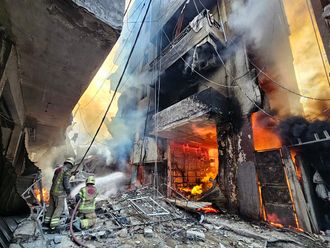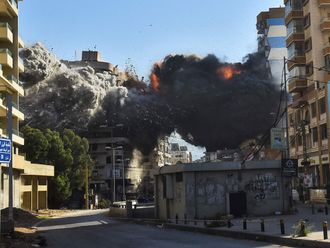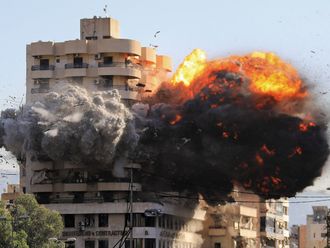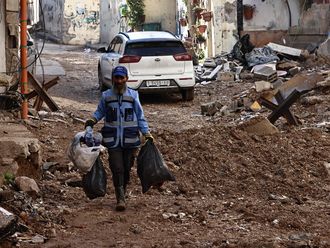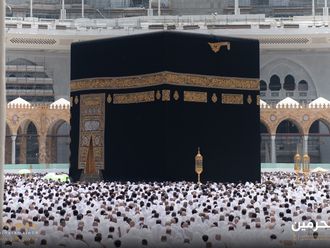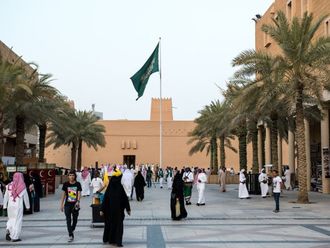
Beirut: Israel’s high-tech air defence system, the Iron Dome, risks getting overwhelmed by missile attacks if the escalating war with Hamas in Gaza expands into a wider regional conflict.
The US-backed system of interconnected radar and mobile missile batteries is designed to shoot down rockets, missiles and mortars that could hit Israeli population centres or important infrastructure.
It has been lauded for reaching a 90 per cent interception rate in past attacks.
But like any air defence system, it relies on sufficient stocks of interceptor missiles and can be overrun if the incoming assault is large enough.
Hamas, which the US and European Union have designated a terrorist group, fired 3,000 rockets in the first 20 minutes of its surprise October 7 attack, a major increase from previous operations, according to Patrick Sullivan, the director of the US Military Academy’s Modern War Institute. The group’s missiles were also more advanced than in previous incidents.
Hezbollah’s precision missiles
Now American officials are worried about the possibility of Lebanon’s Iran-backed Hezbollah firing precision missiles at Israeli cities, while the country’s military gets engaged in grinding urban warfare in densely populated Gaza.
To prevent such a scenario, the US sent two aircraft carriers to the region as a deterrent to those who might seek to take advantage of Israel’s Gaza operation, Secretary of State Antony Blinken said.
Even a small drop in the Iron Dome’s interception rate to around 80 per cent would mean many more rockets would get through should Hamas or others start another round of intense attacks.
With around 100,000 missiles and rockets estimated to be at Hezbollah’s disposal, such an overwhelming offensive and a decline in Iron Dome’s effectiveness are seen as plausible among officials in the Middle East and beyond.
Northern front
Hezbollah is “the world’s most heavily armed non-state actor” and has a large, diverse stockpile of unguided artillery rockets and ballistic, anti-air and anti-tank missiles, said Shaan Shaikh, an associate fellow at the Center for Strategic and International Studies in Washington, DC.
“If Hezbollah enters the ongoing conflict, there is absolutely a risk of Iron Dome defenses getting overwhelmed by rocket fire,” he said.
“Hezbollah’s missile arsenal, of course, dwarfs that of Hamas and exceeds it in quality and accuracy,” according to Alexander Downes, professor of political science and international affairs at The George Washington University in the US. “If it launches massive salvos, some will get through.”
Israel could tap other defensive systems
While Iron Dome is used to counter short-range rockets, the entry of more advanced weapons into the war could also see Israel tap other defensive systems like “David’s Sling” and Patriots for longer-range rockets and drones.
Their use would add further to Israel’s defence costs at a time when military supplies are already stretched by a rapid mobilization of reservists. Each Iron Dome interceptor costs tens of thousands of dollars, according to Israel’s Institute for National Security Studies, known as INSS. Hamas’s rockets, while more advanced than they used to be, are cheaper to produce than Israel’s, making it easier for the group to replenish its stocks.
Strategic shift
Backed by the US and produced by Rafael Advanced Defense Systems and Raytheon Technologies, Iron Dome is designed with resource limitations in mind. The system only intercepts rockets that are expected to hit populated areas, ignoring those bound for empty space.
A wider war would mean tough choices about how to allocate those resources to defend civilians and the military.
“I think the Israeli public understands that the war with Hezbollah will not be like a war with Hamas,” said Kobi Michael, senior researcher at the INSS.
Israel would likely shift from trying to intercept missiles to trying to destroy launch sites before they’re used, said CSIS’s Shaikh.
The US has already dispatched extra military aid to bolster Israel’s supplies including Iron Dome interceptors and other air defenses. Many in Washington are calling for more.
Republican member of the Armed Services Committee Senator Tom Cotton wrote on X, formerly Twitter, that President Joe Biden should follow his predecessor Richard Nixon’s example from the 1973 Arab-Israeli war.
“Send everything that shoots on everything that flies.”


